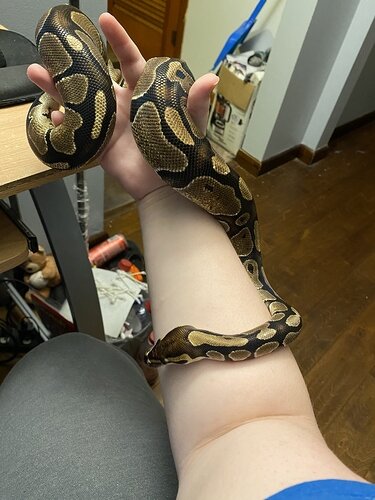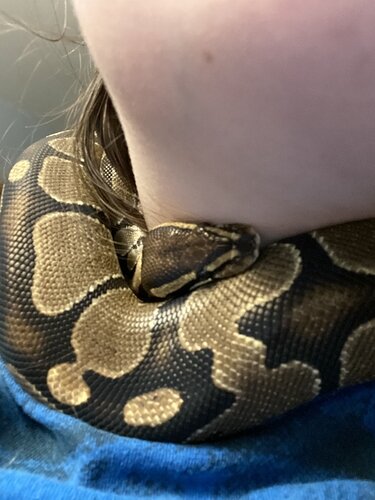Always a pleasure to help.
Funny you mention these things. My first ball python, Delta, has some of these exact traits you mention, as well as tracks along the belly.
I have always wondered if she might be het pied, because she looks so similar to the ones I have that were actually sold to me as het pied. I got her from a chain pet store of course, so I don’t know anything about her genetics.
You have a Banana Pied male right?
I see a project in your future lol.
Yes, I do have a banana pied male! I’m actually trying to pair him to one of my het pied females, he’s been showing interest in breeding but I haven’t caught any confirmed locks on them yet.
I’d say Delta will likely be breeding size fairly soon, she’s been a slow grower but is sitting around 850-900 grams now. Maybe not this coming season but the season after!
There is a really old interview with Mark Mandic (Reptile Radio maybe) where he talked about getting started in the pied projects. He used a het male and bred it to normal females and then held back the baby females with “markers.” So he is another breeder that was able to see something early on.
Personally, I have always believed that “het pied” is a morph on its own. I’ve seen what it does in some of the animals that I’ve produced, especially in enchi and black pastel combos.
I wonder if this would also maybe explain why het pied reacts to champagnes in such a way that makes them look like a “visual” pied.
@trnreptiles champagne is a whole another beast lol. Champagne can make pied looking snakes in single gene form. I feel certain gene increases the odds of this happening. Pied would probably most likely be one of them. I have a black pastel champagne het ghost male. And he throws pied looking snakes with anything he touches!
Can you send him to my house please? ![]()
@projectpython He’s fall out from my failed grey matter project. Almost sold him a few times. But I end up using him every year. And he never disappoints!
Pete was not the only one that could pick them out. I remember overhearing a rather large breeder at a show, back when poss hets still caught higher dollars, tell someone “I love ‘poss het’ Pieds. I can tell which ones will prove out and keep them back and then sell the ones I know will not prove at a higher price because of the ‘poss het’ label.” Seemed like it was one of those “industry secrets” back then that the big guys knew but kept to themselves
.
.
.
While I do not discount the tracks, I do not put as much stock in them. I have seen hets without them and I have seen plenty of non-hets with them. So for me, they are more a kind of secondary indicator
.
.
.
Correct. If the heterozygous form has a consistent visual phenotype, then it is not recessive but instead is incomplete-dominant
Sort of yes. These reactions have to do with the genes for all three mutations having some level of interaction along a shared genetic program pathway. That the pathway sees such disruptions indicates that the presence of the WT allele of Pied is not sufficient to counter the effects of the mutant allele. If it were truly recessive, like Albino for example, then there would be no cumulative synergistic effect
.
.
.
Yes, nature of the mutation with Champ does seem to predispose them to throwing ringers at a higher frequency even in the base state. But your specific animal might have more to do with the BlkPastel/Champ genes interacting as I mentioned above
So question, to keep it consistent with the rest of the morphs we’ve classified, should we just be discussing het pieds, not combos? Isn’t everything else is classified based off its single mutation form? There’s zero doubt many combos show the het pied.
maybe UC Davis has done some study on reptiles or someone there is willing to. https://vgl.ucdavis.edu/test/piebald-dog
You can contact them here.
I think yes and no.
Once you throw other genes in with the het Pied, then that would require more breeding out to figure if it’s the combination of these genes affecting what we’re seeing, or if it’s the het Pied contributing to it.
But like the Cinny het Pied Brandon posted, that pattern is obviously being effected by the het Pied influence, so if we could recognize stuff like that with other single gene morphs, maybe Pied can be proven to be inc-dom. Cause as Travis states, recessives show no visual phenotype, so if we’re seeing visual differences with this, how can it be recessive?
But I think to get things correct, we would have to look at the het Pieds as a group and see the similarities each snake shares. Breed Pieds to normals, over and over to try and see a pattern if they are indeed different than your average WT.
I don’t even know if it’s worth the work but I think it would be important to classify the gene if it’s a inc-dom.
I think the problem with the industry when it comes to labeling mutations as recessive or inc-dom (in this case Pied) is based on ‘ease of identification’. Pied is labeled recessive due to it being hard to ID, at least in the past. I would assume the average breeder’s eye is trained enough at this stage in the industry to see that Het Pied does bring enough influence to question its true recessive status. I can say I haven’t seen a het pied that didn’t look slighty off to me.
Also the champagne het pied is pretty damning if I would say so myself.
I personally think some recessives (pied, cryptic, clown? Monsoon ) should be re-examined or ‘re-evaluated’ to some degree when it comes to if they are ‘True Recessives’ like Albino or Lavender albino.
I would argue inc-dom compared to what? I think the standard has been compared to normal. If we throw combos into the mix, we might not have many morphs to classify as recessives in the hobby. Clown and hypo in my experience start showing with some combos. Some say albino too, but personally I’ve never noticed anything different on my het albinos.
Inc-dom compared to recessive.
I don’t have the experience with Hypo or Clown to either confirm or deny that start to show any influence within combos. And Id agree with the few het Albino I’ve worked with, I don’t see a difference.
But if we did start throwing combos into the mix with het Pied, and other recessives, I don’t think it would necessarily be hurtful to the hobby or the market if some recessives proved to be inc-dom or dominant genes from the visual difference a het brings to a combo. Like Bongo. Het Pied has the same impact on Bongo as it does on Cinnamon. Completely changes the visual display of that morph, and if it’s really recessive, how can that happen?
I was just informed by Travis about some people thinking Pied may be inc-dom a few days ago. And once I start thinking about it, and looking closer at combos and regular het Pieds, I can see how that holds some truth.
Merged with second post below.
In my opinion, no.
You’ll notice that many breeders skip generations with retics/balls/boas by breeding together 50% hets that they produced, and most of the time all their 50% het holdbacks prove out.
Virtually every recessive gene aside from albino leaves markers, typically these markers can confirm but not deny the presence of a het.
Breeders put in a lot of time and effort examining their hets, and when it’s all said and done, they can usually pick out at least a few they are certain will prove out.
So for example. Lesser is recessive compared to bamboo. At least with information we have now, phenotype is the same for super bamboo and lesser bamboo. However super lesser you get the potential bug eyes. Lemonback compared to fire, fire is recessive, as super fires cna have the yellow splotching. We call all of them inc-dom because of them being compared to normals. So that why i think we should be classifying based of what we see in het pieds. not comparing champagne cinny het pieds to champagne cinnys, where it would most likely be very visual.
Ok I got ya. Thank you for laying it out like that, makes more sense that way with how you put it.
Because correct me if I’m wrong, isn’t all genes technically recessive in some degree? For example a pastel really is het pastel and the true display of that gene is the super pastel, same can be said for each other gene if I’m not mistaken? Or because these heterozygous genes display consistently they are inc-dom? Genetics are not something I’m very good at so any correction is appreciated.

